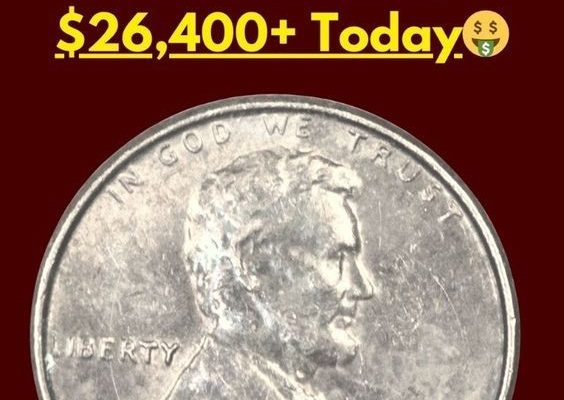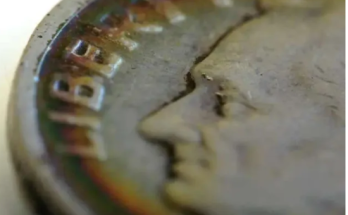This staggering value difference is due to various nuances of the 1973 Lincoln Penny, such as its condition, color, and rare features. You might miss a hidden gem if you can’t spot these features! So, this guide will explain how to identify rare mint marks, minting errors, and various factors that contribute to its true worth!
History of the 1973 Lincoln Memorial Cent
Designed by Victor David Brenner, The Lincoln Penny was first introduced in 1909 to commemorate the 100th anniversary of Abraham Lincoln’s birth. By 1973, the penny had already undergone several changes, including the switch from wheat ears to the Lincoln Memorial reverse design in 1959.
1973 marked a significant year for the U.S. Mint as it struggled with rising copper prices. This economic pressure led to the change in penny composition in 1982. But, in 1973, the copper content remained unchanged, making these pennies more valuable in metal content than their face value today.
| 1973 Lincoln Memorial Cent | Key Features & Facts |
| Coin Composition | 95% Copper, 5% Tin and Zinc |
| Minting Location | Philadelphia, Denver, San Francisco |
| Minting Year | 1973 |
| Face Value | 1-cent (0.01$) |
| Weight | 3.11 grams |
| Diameter | 19.05 mm |
| Thickness | 1.52 mm |
| Designer | Victor David Brenner, Gilroy Roberts |
| Mint Marks | D – Denver Mint, S – San Francisco no mint mark – Philadelphia Mint |
| Total Mintage | 7,597,759,222 |
Identifying a 1973 Lincoln Penny Design & Composition
To accurately spot a real 1973 Lincoln Penny, it’s crucial to understand its design elements on both sides and composition.
1973 Lincoln Penny Obverse:
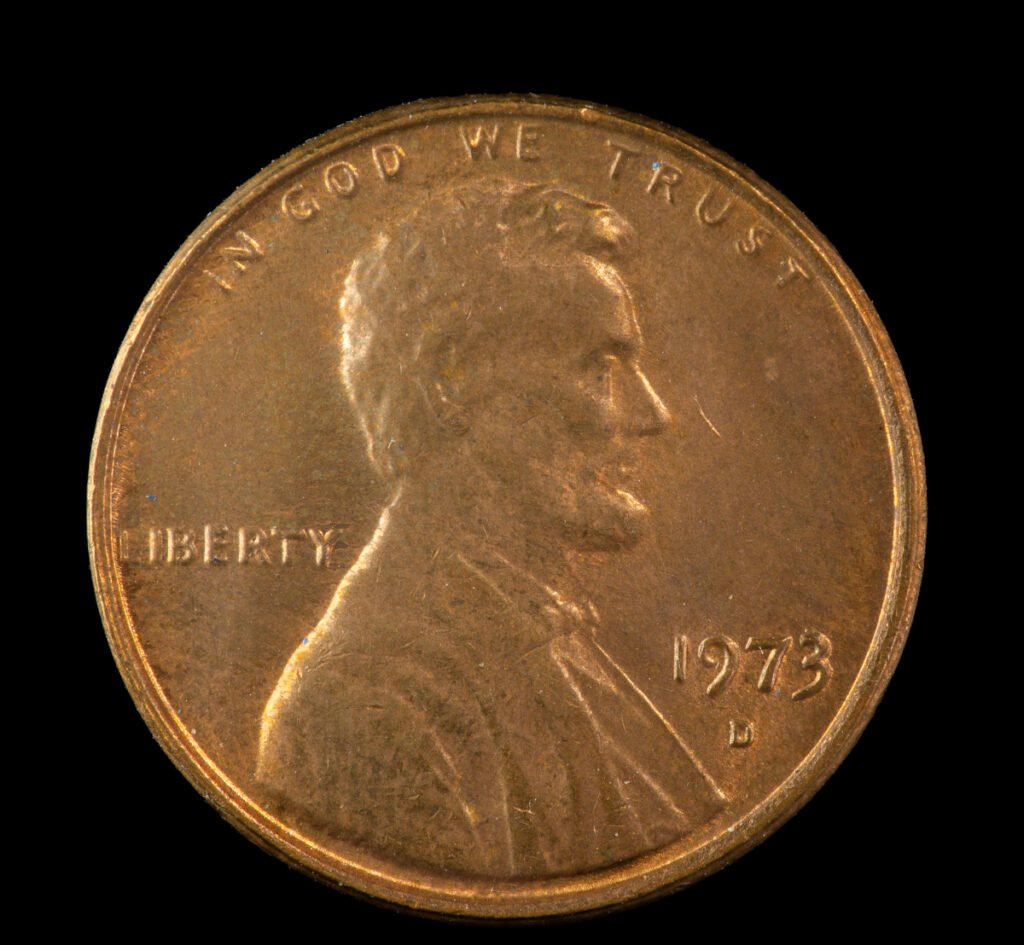
- Portrait of Abraham Lincoln facing right
- The US motto “IN GOD WE TRUST” above Lincoln’s head
- The word “LIBERTY” inscription to the left of Lincoln
- The mint date “1973” to the right of Lincoln
- The mint mark, if present, below the mint year
1973 Lincoln Penny Reverse:
- Lincoln Memorial building at the center
- “UNITED STATES OF AMERICA” along the top edge
- “E PLURIBUS UNUM” above the Memorial
- The face value “ONE CENT” below the Memorial
- The sculptor’s initials, “FG,” on the right side of the staircase
Coin Composition and Dimensions:
The 1973 Lincoln Penny is composed of 95% copper and 5% zinc. This composition gives the coin a distinctive reddish color when newly minted, which can change over time due to oxidation.
As for its size, the 1973 penny weighs 3.11 grams and has a diameter of 19.05 mm (0.75 inches). The coin’s thickness is 1.55 mm (0.0610 inches), and it features a plain edge.
Assessing the 1973 Lincoln Cent Value (5 Key Factors)
Generally, a circulated 1973 Lincoln Cent is worth its face value of one cent. However, uncirculated pennies or those with rare features can be worth significantly more, ranging from $5 to several thousand dollars, depending on various factors explained below.
1. Coin Grading and Condition
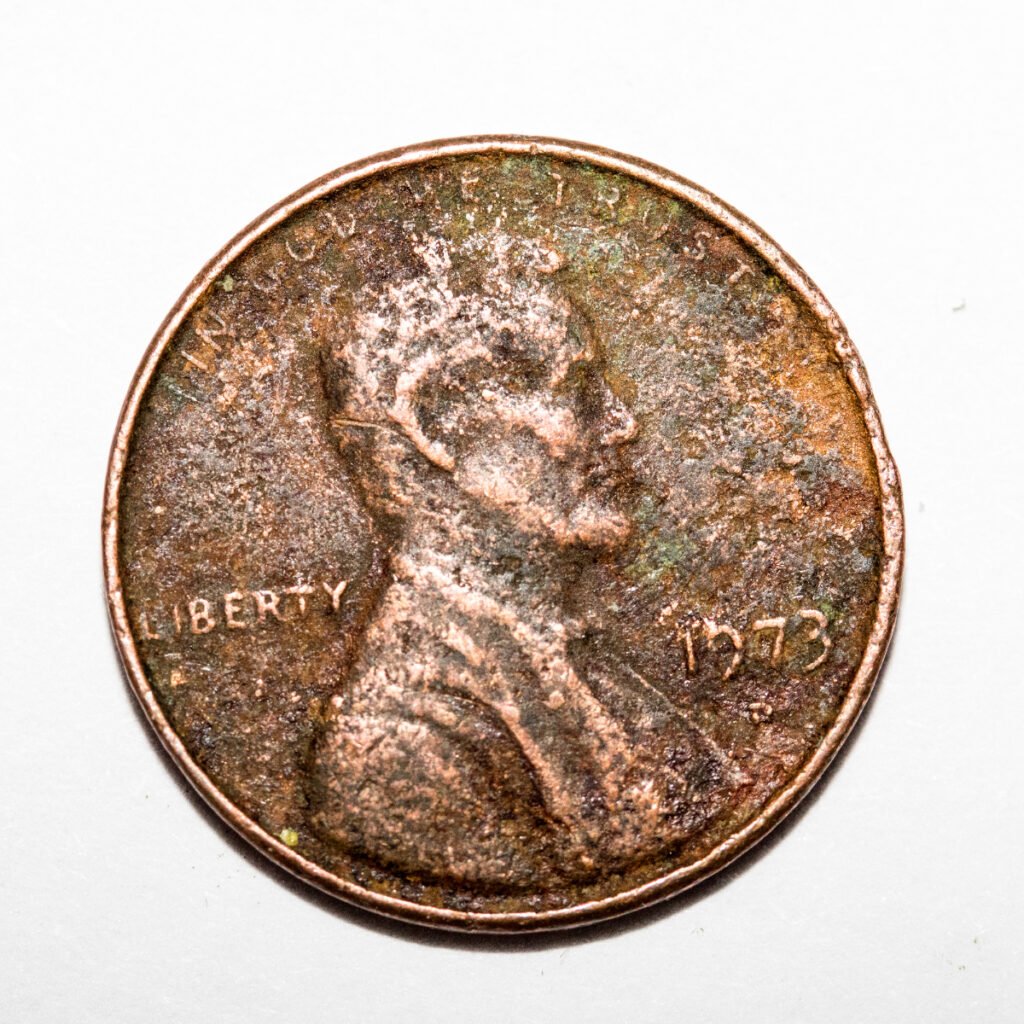
💌 Daily One Friendly Email from Me on Old & Antique Wonders
One email, 5 minutes, countless discoveries. No SPAM, just our shared love for old treasures.
The condition of a 1973 Lincoln Cent is the first and most important factor that determines its value. Professional grading services use a scale from 1 to 70, with 70 being a perfect, flawless coin.
For 1973 pennies, coins graded MS-67 (Mint State 67) or higher can command higher prices of $500 or more, while lower-grade coins range from the face value to a few dollars.
2. Coin Toning & Discoloration
While all the 1973 Lincoln Cents are reddish-brown in color, some coins appear to be more brown due to oxidation. Based on this coloration, the 1973 Pennies are categorized into three color designations, which can affect their value:
- Red (RD): The RD 1973 cents retain 95% or more of their original copper color. These are the most valuable, with uncirculated red pennies worth $0.30 to $50 or more.
- Red-Brown (RB): Pennies with 5% to 95% of their original red color are graded RB. These are less valuable than full red coins but more than brown ones.
- Brown (BN): 1973 pennies with less than 5% of their original red color are graded BN. These are typically the least valuable unless in exceptionally high grades.
3. Mint Marks & Mintage
The 1973 penny was minted in large quantities across three different mints, totaling 7,597,759,222, reflecting its importance during that era. However, this high mintage also makes the coin quite common and, hence, less valuable.
However, 1973 pennies from certain mint locations can still fetch a decent price. You can identify the mint location by the mint mark on the coin’s obverse.
- 1973 No Mint Mark Penny (3,728,245,000): These 1973 pennies were struck by the Philadelphia Mint and bear no mint mark. Due to their high mintage, 1973 no mint mark pennies are the least valuable, with circulated examples fetching $0.30 to $1.50 and common mint examples (MS67) fetching $100 – $350!
- 1973 D Penny (3,549,576,588): These 3.5 billion 1973 Lincoln Pennies were minted at the Denver Mint, identified by the “D” mint mark below the date. They are slightly more valuable than Philadelphia cents, with uncirculated examples (MS67) worth $400 to $800!
- 1973 S Lincoln Penny (317,177,295): These 1973 pennies struck by the San Francisco Mint can be spotted by the small “S” mint mark on the obverse. Due to the lowest mintage, the 1973 S Penny is more valuable. While circulated coins are still worth the face value, mint condition (MS67) examples can fetch up to $1,000 – $2,000!
The following 1973 Lincoln Cent coin value chart will help you find the average value of your coin based on its condition!
| Coin Grades | Condition Details | 1973 No Mint Mark Penny Value | 1973 D Lincoln Penny Value | 1973 S Lincoln Penny Value |
| Poor (0) to Extremely Fine (XF45) | Significant wear, faded but visible details | Face value or slightly more | Face value or slightly more | Face value or slightly more |
| Almost Uncirculated (AU50) to Mint State (MS60) | Slight wear on highest points, visible marks or blemishes | 30 cents to $1 | 30 cents to $1 | Below $5 |
| Mint State (MS61 – MS64) | Uncirculated with minimal wear | $1 – $5 | $1 – $8 | $5 – $30 |
| Mint State (MS65 – MS66+) | Nearly flawless with very minor imperfections | $5 – $25 | $5 – $150 | $7 – $500+ |
| Mint State (MS67 – MS67+) | Well-preserved with no major flaws | $150 – $3,000+ | $400 – $3,700+ | $400 – $2,500+ |
| Mint State (MS68 or Above) | Nearly perfect, luster, no major marks or flaws | N/A | N/A | N/A |
4. 1973-S Lincoln Penny Proof Coins
In 1973, the San Francisco Mint also produced 2,760,339 proof coins in addition to regular pennies. These coins were struck using specially polished dies and planchets, resulting in a mirror-like finish that can greatly impact their value.
Based on the design details, 1973 S 1C proof pennies are divided into three categories :
- Regular Proofs: These proof cents have a regular mirror-like background with frosted design elements. The value of these coins ranges from $1 to $5 for common grades.
- Cameo Proofs (CAM): CAM-graded 1973 proof coins feature more contrast between the mirrored fields and frosted devices. They’re worth $5 to $15 in most grades.
- Deep Cameo (DCAM) Proofs: These proof coins have the strongest contrast between the background and the design. 1973-S 1C DCAM proofs can be worth $15 to $50 or more, depending on the grade, like this PF69 DCAM example sold for $380 on eBay.
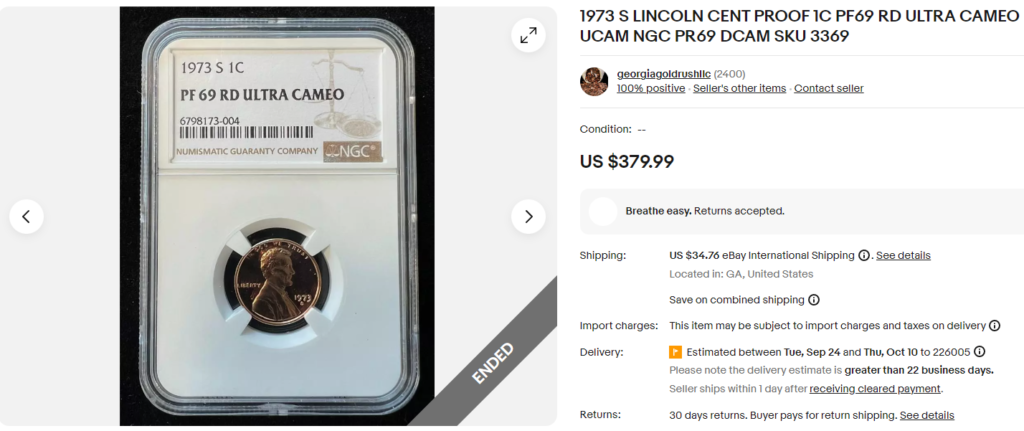
Here’s is a quick value chart for the 1973 1C Proof Coin (DCAM) value:
- PR70DCAM: $5,000 – $12,000
- PR69DCAM: $1,500 to $2,000+
- PR68DCAM: $300 to $500
- PR67DCAM: $150 to $250
5. 1973 Lincoln Cent Mint Errors & Rarities List
Mint errors or anomalies that occur during the minting process can significantly increase a coin’s value. Here are some notable mint errors to look for in 1973 Lincoln Pennies:
Die Cud or Die Break Error
This error happens when a part of the die used to strike the coins breaks away, creating a raised lump on the coin’s surface, often along the rim, where the metal has flowed into the gap created by the broken die.
The value of die cud errors can vary based on their visibility and the coin’s condition. For example, an MS65RD graded 1973 penny with a major die break sold for over $400 on Heritage Auctions.
Struck on Dime Planchet
This is an extremely rare mint error, a result of a 1973 penny mistakenly getting struck on a dime planchet. You can spot this rare coin with its silvery grey finish (unlike a copper coin). This error coin can be worth $200 to $1,000 or more, depending on the condition.
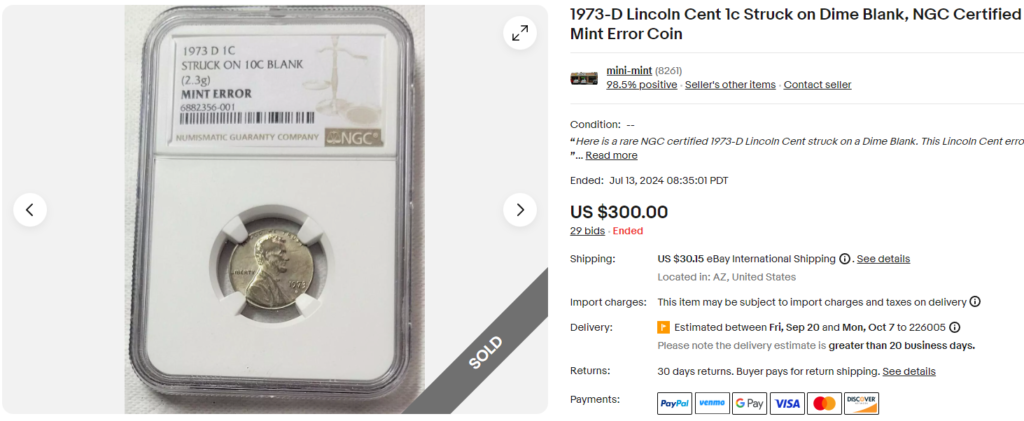
Double Die Obverse (DDO)
This error occurs when the die strikes the coin twice at slightly different angles, creating a doubled image. On 1973 pennies, look for a doubling on the date, “LIBERTY,” or “IN GOD WE TRUST.” A strong DDO can increase the coin’s value to $50-$100 or more.
Raised Edge or Raised Rim Error
This minting error features an unusually thick or raised rim around the 1973 Lincoln Cent coin’s edge, resulting from the die used to strike the coin getting tilted or misaligned. Circulated 1973 Lincoln pennies with raised rim errors are valued at around $10 or less, but coins with an extremely pronounced rim may be worth $50 to $100.
5 Steps to Spot a Fake 1973 Lincoln Penny
It can often be challenging to find a real 1973 Lincoln Memorial Cent from a big lot. In that case, follow these five simple steps to distinguish fakes:
- Check the Weight: Use a precise scale to ensure your 1973 penny’s weight. If it doesn’t weigh 3.11 grams, it’s fake.
- Verify the Composition: Genuine 1973 pennies are made of copper and aren’t magnetic. Bring a magnet near your coin. If it reacts, it could be a counterfeit.
- Examine the Edge: The edge of your 1973 penny should be plain and uniform, without seams or signs of joining.
- Verify the Mint Mark: Ensure the mint marks “S” and “D,” if present, are in the correct font, style, and position.
- Consult a Professional: If you’re still in doubt, contact a professional coin grading service to authenticate your coin!
